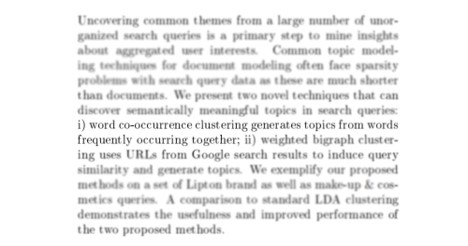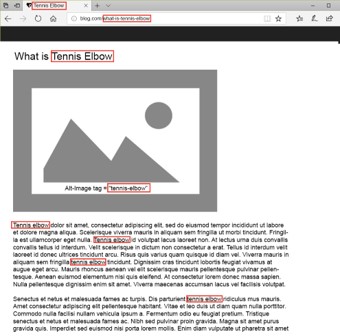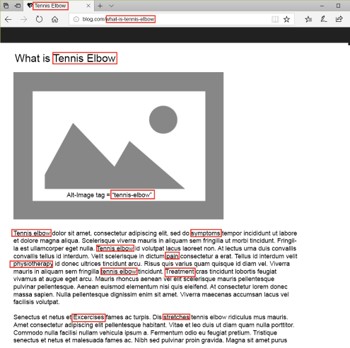Latent Semantic Indexing Keywords, or LSI Keywords, are words or phrases that search engines use to deeply understand a piece of content on a website. These terms are conceptually related to the page’s primary keyword/s.
LSI keywords are becoming increasingly important. Why? Because put simply, search engines are smarter!
If you’re about to click that cross in the corner, thinking “I’m all over LSI keywords – I’ve got a whole bunch of similar keywords and terms in my content”, then stop right there. Take your cursor off the close button, sit down and get ready to read on! LSI keywords are NOT just synonyms which is what many people believe to be true; and where many companies are going very wrong.
Why LSI Keywords?
So… back in the day, if Google saw a page with the title “What is Tennis Elbow”, its URL and H1 had “tennis elbow” and content talked about “tennis elbow”, Google would assume that yep, this page is in fact about “tennis elbow”.
BUT… search engines are smarter, and it looks like the latest updates to the Google algorithm are taking some of this intelligence to a new level. In fact, in a paper from Google, it stated that “word co-occurrence clustering generates topics from words frequently occurring together”.

You can read more from the paper on improving semantic topic clustering for search queries with word co-occurrence and bigraph co-clustering here.
These days, as well as looking at the key term (tennis elbow), they are also scanning the page for LSI keywords. These are words that are closely related to your target keyword. So it looks for terms like “brace”, “exercises”, “physiotherapy”, “treatments”, “symptoms”, “pain”, “stretches”, and once they see these LSI terms appearing the search engine can now confirm that yes, this page is about the topic “tennis elbow”.
So basically, search engines now use a process of latent semantic analysis to determine the overall topic of any given web page. Of course, search engines will still be scanning things like your URL, title tag, H1, alt image tag and content for your main keyword. But they’ll also be looking for those highly correlated words – just to confirm that the page is in fact about that topic, and it will be in its user’s interests to present the web page in search results.
How search engines are crawling pages
The old way search engines crawled a webpage

The NEW way search engines crawl pages – Looking for LSI keywords!

LSI Keywords – Benefits for SEO
As mentioned above, search engines like Google are now using LSI Keywords to determine the validity of a page topic. This means that if you leave your page content in the olden days just with basic keyword optimisation, you’re likely to already have seen and continue to see a decline in your page ranking.
To give your web pages the best chance at ranking organically, they need to follow Google’s SEO ‘rules’ as closely as possible – which now means inputting these LSI keywords into your content.
Of course, there are more positives than just improving SEO. As LSI keywords are terms that users are searching for when looking for your keyword, it means including them in your content also gives your customers (or potential customers) the best information about that topic possible. So really it’s a win-win; keeping Google happy and your customers happy!
What is the difference between LSI Keywords and long-tail keywords?
Long-tail keywords are keywords or phrases that are usually longer than the target keyword and that are derived from the target keyword. They are usually more specific in nature than the target keyword and will have fewer search results. But due to their specific nature, they are more relevant when those users searching these longer tail terms do search for them. Some examples of long-tail keywords would include ‘remedies for tennis elbow’, ‘how to treat tennis elbow’, and ‘tennis vs golfers elbow’. For example, if you were a user and searched for “how to treat tennis elbow” and the first two search results were “About Tennis Elbow” or “How to Treat Tennis Elbow”, which would you choose? Of course, the latter because it directly answers your query!
Long-tail keywords are still great for SEO! While search volumes for long-tail keywords are less than the target keyword, they do offer a more specific audience – and one who is more likely to click if a web page is specifically relating to their long search term (see example above!).
A couple of easy ways to add long-tail keywords into your website include:
- Adding them into your web page (a page about your target keyword) as subheadings (H2’s or H3’s)
- Creating sub-pages or blog pages using the long-tail keyword as the target keyword for the sub-page or blog (and internal linking back to the target keyword page)
How do I find LSI Keywords?
Good question! There are a host of LSI keyword generator tools out there – many of which are completely free. A couple of the keyword research tools we recommend having a look at are:
Alternatively, you can complete some LSI keyword research yourself. Simply pop your keyword into Google search, and you’ll see what users are searching for – these are terms directly correlated to your search term (= LSI keywords!).

In the image above, we entered our keyword “tennis elbow” and you can see the LSI keywords appearing in bold – ‘cure’, ‘brace’, ‘exercises’, etc.
How do I use LSI Keywords?
Once you’ve identified your LSI keywords, you then need to work them into your page content – of course, always being careful to ensure the content is relevant, readable and not duplicated.
A few ways you can look at using your LSI keywords are:
- In your title tag
- As a subheading on the page (using a H2 or H3 tag)
- In your main headline (H1 tag – although this should also include your target keyword)
- Incorporate them into the page content
- Add them in the image alt-tag
- Within your meta description
Like your primary keyword, ensure that you are not keyword stuffing with your list of LSI keywords. Keep an eye on the keyword density.
If you need assistance in optimising your website for SEO, or perhaps just need some direction on where to start, what to do and quite simply, how to grow – contact us today! We take a consultative approach to our work and will discuss what your business objectives are, and then work to marry in our digital recommendations (including SEO) to help achieve your goals. We’d love to grab a coffee and chat through how we can help your business reach the next level!



